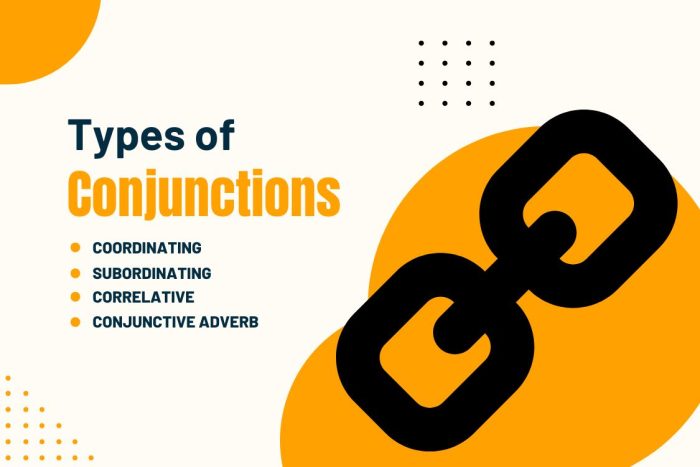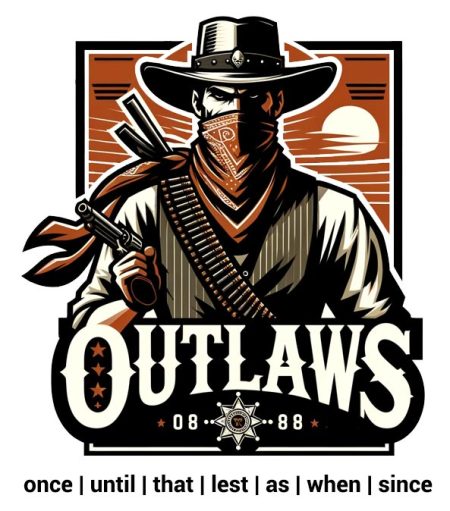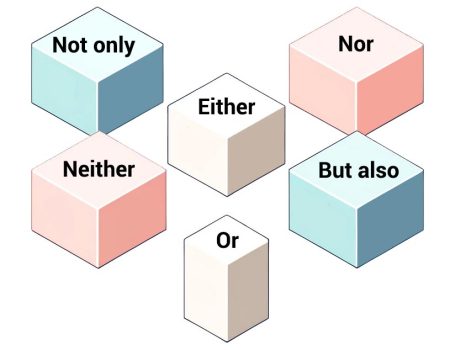4 Types of Conjunctions

Conjunctions join words, phrases, or clauses. For example, they are words like “and”, “but”, and “because”. We use conjunctions in every sentence because they help connect two ideas.
Types of Conjunctions
Conjunctions come in different types. Each has a unique role in the English language, which includes:
- Coordinating conjunctions
- Subordinating conjunctions
- Correlative conjunctions
- Conjunctive adverbs
Let’s explore the types of conjunctions.
1. Coordinating Conjunctions
Coordinating conjunctions connect two parts of a sentence of equal importance. The famous examples are “for,” “and,” “nor,” “but,” “or,” “yet,” and “so,”. We can remember these seven conjunctions by the acronym FANBOYS.

Here are some examples of coordinating conjunctions:
1. She enjoys painting, and he likes drawing.
2. I was hungry, so I made a sandwich.
3. They were late, but they still caught the train.
4. We can watch a movie or play a game.
5. She tried to call you, yet there was no answer.
In each sentence above, the coordinating conjunction links two similar parts together.
2. Subordinating Conjunctions
Subordinating conjunctions link a dependent clause to an independent clause. I’ve heard of using the acronym OUTLAWS for this type of conjunction. This stands for “once”, “until”, “that”, “lest”, “as”, “when”, and “since”.

Here are some examples of subordinating conjunctions:
1. Once you finish your homework, you can watch TV.
2. You must wait here until your name is called.
3. As the sun rises, the birds start singing.
4. When I saw the ocean, I felt calm.
5. Since we met, my life has been better.
We can also use subordinating conjunctions in complex sentences to add depth to ideas. Similar to the other types of conjunctions, they show a relationship between two ideas. Examples include “although,” “because,” “since,” and “unless”, which are also examples of transition words.
3. Correlative Conjunctions
Correlative conjunctions work in pairs to connect equal elements in a sentence. Examples include “either…or,” “neither…nor,” and “not only…but also.”

Here are examples of using correlative conjunctions:
1. You can either have tea or coffee.
2. Neither the manager nor his assistants were available.
3. She is not only talented but also very hardworking.
4. Either you start taking this seriously, or you’ll fail the class.
5. Neither rain nor snow stopped the mail from being delivered.
Correlative conjunctions often come in pairs, like “either/or” and “neither/nor,”. As a result, they link similar elements together for more clarity.
4. Conjunctive Adverbs (Transitional Phrases)
Conjunctive adverbs connect independent clauses while showing a relationship like cause and effect. Examples include “however,” “therefore,” and “moreover.”

Here are some examples:
1. She studied hard for the exam; therefore, she passed with flying colors.
2. It was raining heavily; moreover, there were thunderstorms forecasted.
3. He didn’t like the meal; however, he didn’t complain about it.
4. The project deadline was near; consequently, the team worked overtime.
5. She was qualified for the job; nonetheless, she wasn’t offered the position.
You often join conjunctive adverbs with a semicolon or a period. Plus, you often add a comma as part of the second clause.
Tips For Using Conjunctions
Here are my biggest tips for using conjunctions in everyday English:
- Know the type of conjunction you need based on the relationship between your ideas.
- Using too many conjunctions can make a sentence difficult to follow.
- Enhance your writing style by avoiding using the same type of conjunction repeatedly.
- Place coordinating conjunctions between the phrases they link.
- Use a comma before a coordinating conjunction joining two independent clauses.
If you can master using conjunctions, this can greatly improve both your writing and communication skills.
Conclusion
Conjunctions build connections between sentences. They also help show the relationship between ideas, making our writing easier to understand.
Do you have any questions? Please let us know in the comment section below anything you need to know.
